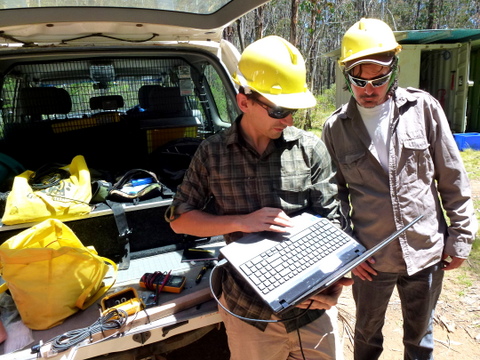Cassidy Rankin (at left) of the University of Alberta works with University of Canberra student Michael Hausch (at right) on the AusCover Sensor Network at OzFlux’s Tumbarumba site.
The great work of TERN’s OzFlux Facility is on show this month in a special issue of the international journal Agricultural and Forest Meteorology.
‘OzFlux has been the catalyst for a significant advance in what we know of the land-air exchanges of carbon and water across a range of ecosystems and meteorological conditions,’ said facility leader Dr Helen Cleugh of CSIRO. OzFlux’s data, networks and analytical models are now being widely used in the research fields of ecology, plant science, forestry, meteorology and atmospheric science.
Ten of the papers in the special issue involve TERN infrastructure or data products, including:
- Beringer, J., Livesley, S. J., Randle, J., & Hutley, L. B. (2013). Carbon dioxide fluxes dominate the greenhouse gas exchanges of a seasonal wetland in the wet–dry tropics of northern Australia. Agricultural and Forest Meteorology, 182–183(0), 239-247. doi: http://dx.doi.org/10.1016/j.agrformet.2013.06.008
- Cleugh, H. (2013). Preface for the special issue on water and carbon coupling to honour Dr Ray Leuning. Agricultural and Forest Meteorology, 182–183(0), 189-190. doi: http://dx.doi.org/10.1016/j.agrformet.2013.08.009
- Eamus, D., Cleverly, J., Boulain, N., Grant, N., Faux, R., & Villalobos-Vega, R. (2013). Carbon and water fluxes in an arid-zone Acacia savanna woodland: An analyses of seasonal patterns and responses to rainfall events. Agricultural and Forest Meteorology, 182–183(0), 225-238. doi: http://dx.doi.org/10.1016/j.agrformet.2013.04.020
- Kanniah, K. D., Beringer, J., & Hutley, L. (2013). Exploring the link between clouds, radiation, and canopy productivity of tropical savannas. Agricultural and Forest Meteorology, 182–183(0), 304-313. doi: http://dx.doi.org/10.1016/j.agrformet.2013.06.010
- Kilinc, M., Beringer, J., Hutley, L. B., Tapper, N. J., & McGuire, D. A. (2013). Carbon and water exchange of the world’s tallest angiosperm forest. Agricultural and Forest Meteorology, 182–183(0), 215-224. doi: http://dx.doi.org/10.1016/j.agrformet.2013.07.003
- Lu, X., Wang, Y.-P., Ziehn, T., & Dai, Y. (2013). An efficient method for global parameter sensitivity analysis and its applications to the Australian community land surface model (CABLE). Agricultural and Forest Meteorology, 182–183(0), 292-303. doi: http://dx.doi.org/10.1016/j.agrformet.2013.04.003
- Medlyn, B. E., Duursma, R. A., De Kauwe, M. G., & Prentice, I. C. (2013). The optimal stomatal response to atmospheric CO2 concentration: Alternative solutions, alternative interpretations. Agricultural and Forest Meteorology, 182–183(0), 200-203. doi: http://dx.doi.org/10.1016/j.agrformet.2013.04.019
- Raupach, M. R., Haverd, V., & Briggs, P. R. (2013). Sensitivities of the Australian terrestrial water and carbon balances to climate change and variability. Agricultural and Forest Meteorology, 182–183(0), 277-291. doi: http://dx.doi.org/10.1016/j.agrformet.2013.06.017
- van Gorsel, E., Berni, J. A. J., Briggs, P., Cabello-Leblic, A., Chasmer, L., Cleugh, H. A., . . . Zegelin, S. (2013). Primary and secondary effects of climate variability on net ecosystem carbon exchange in an evergreen Eucalyptus forest. Agricultural and Forest Meteorology, 182–183(0), 248-256. doi: http://dx.doi.org/10.1016/j.agrformet.2013.04.027
- Zhou, S., Duursma, R. A., Medlyn, B. E., Kelly, J. W. G., & Prentice, I. C. (2013). How should we model plant responses to drought? An analysis of stomatal and non-stomatal responses to water stress. Agricultural and Forest Meteorology, 182–183(0), 204-214. doi: http://dx.doi.org/10.1016/j.agrformet.2013.05.009
Some of the key the datasets associated with these publications are available for download via TERN and OzFlux data infrastructure – check them out in this month’s Data Update.
Published in TERN newsletter December 2013







